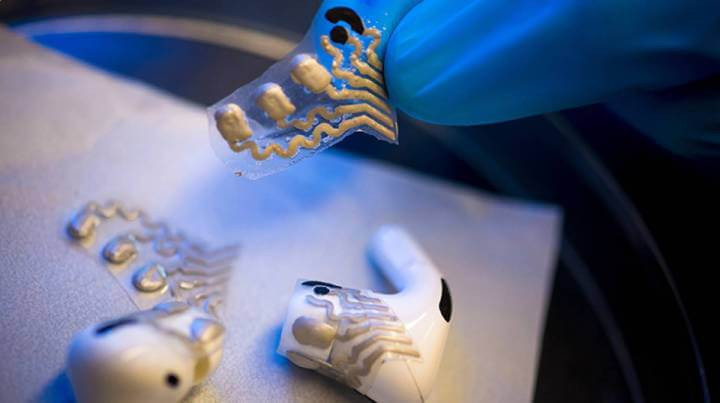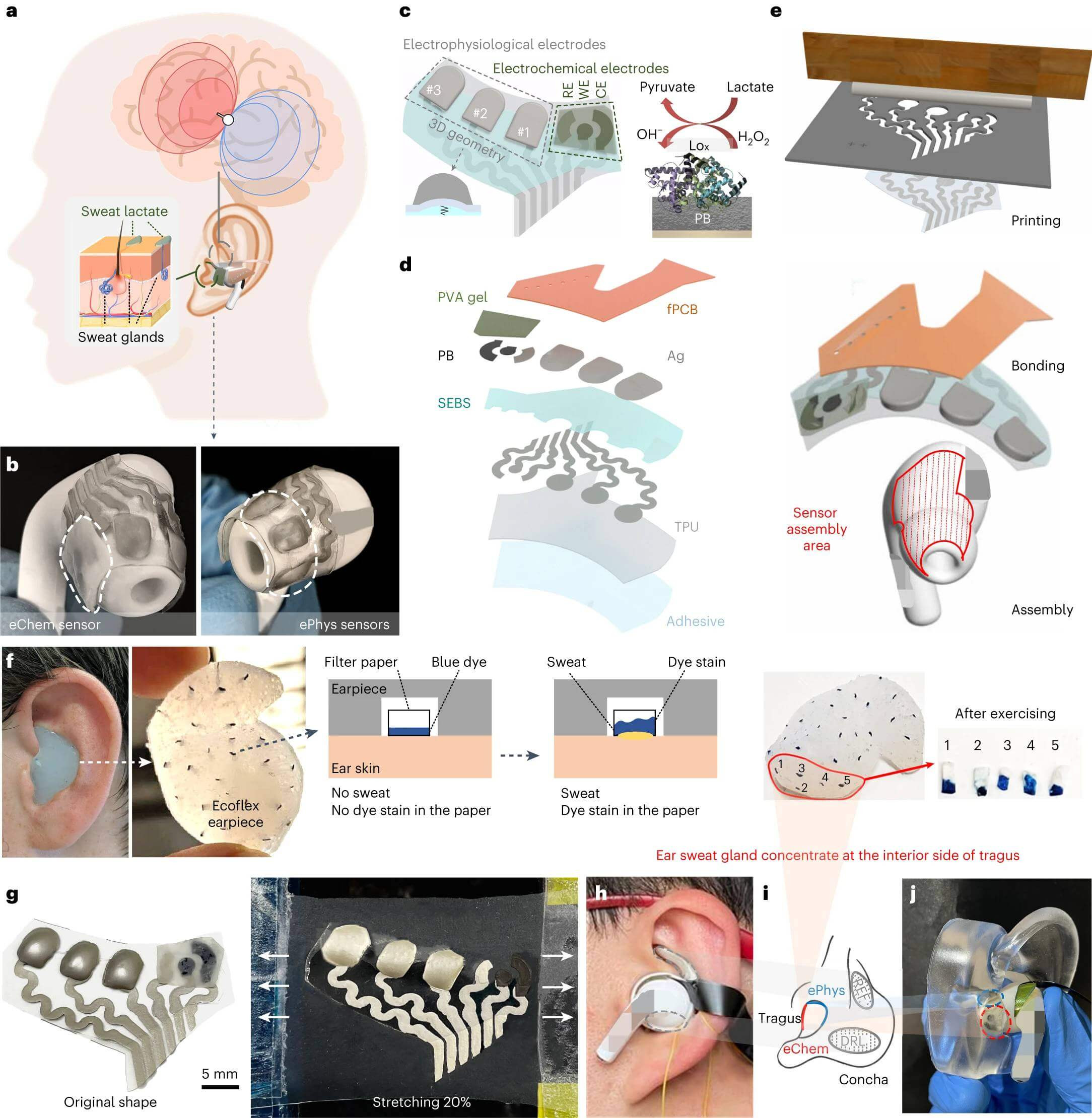Earbuds with Screen-Printed Sensors Detect Neurodegenerative Conditions
Insights | 10-10-2023 | By Robin Mitchell
Recognising the challenges faced with recording brain activity, researchers have recently developed a printed biosensor that can be attached to earbuds to provide real-time brain data. What challenges does recording brain activity present, what did the researchers develop, and how could such sensors help with future medical testing?
 Attached to the earbuds, these screen-printed, flexible sensors are affixed to a pliable, stamp-like surface. Credit: UC San Diego
Attached to the earbuds, these screen-printed, flexible sensors are affixed to a pliable, stamp-like surface. Credit: UC San Diego
What challenges does recording brain activity present?
Medical sensors have undergone all kinds of advances over the past few decades, with wearable devices now able to record key biomarkers, including heart rate, bloody oxygen, and activity. The ability to collect massive amounts of data from wearers through the day every single day not only presents major opportunities in long-term medical monitoring but also provides researchers with huge amounts of data to train next-generation AI systems capable of diagnosing individuals in real time.
One biomarker that could prove to be extremely valuable is brain activity, as brain activity can indicate countless conditions and illnesses, including headaches, nightmares, epilepsy, strokes, and dementia. However, trying to record brain activity can be complex, as multiple sensor pads need to be attached to the head across various locations, and these many pads need to connect to a central controller, thus tying the individual down and providing limited mobility.
The recent advancements in biosensor technology, as highlighted in the University of California article, offer a promising solution to these challenges. By integrating flexible sensors into commonly used earbuds, it becomes feasible to record brain activity without the need for cumbersome equipment or invasive procedures. This innovation could revolutionise the way we monitor and diagnose various neurological conditions.
While brain implants can get around this issue, their invasive nature means that patients need to go through enormous amounts of stress and suffering to be monitored. Worse, the installation of such sensors can result in permanent brain damage through damaged nerves and blood vessels.
Even if a wireless non-invasive brain activity sensor is developed, current technology does not make this practical for use in everyday activities. Finally, the number of sensors needed across the head means that a wearer would need a large covering over their head, something that the vast majority of people would find uncomfortable.
Researchers develop in-ear brain activity sensors into earbuds
Recognising the challenges faced with brain activity sensors, researchers from the University of California San Diego have published their findings on a newly developed sensor that can be incorporated into existing earbuds and provide real-time brain activity.
To manufacture their brain sensors, the research team turned to flexible printed electronics that, once built, can be overlayed on top of existing off-the-shelf earbuds. The sensors, which utilise screen printing technologies, are able to not only detect brain activity but also lactate levels in sweat, which can be indicators of various medical conditions.

a. Design schematic of in-ear sensors highlights electrophysiological and electrochemical sites for brain activity and sweat. b. Assembled sensors emphasize electrode locations. c. Sensor layout showcases 3D cushioned electrophysiological electrodes and lactate sensing mechanism. d. Sensor structure comprises adhesive, TPU, SEBS, PB, stretchable Ag, PVA hydrogel, and fPCB. e. Fabrication process involves printing, bonding with electronics, and earphone assembly. f. In-ear sweat mapping uses an Ecoflex earpiece for sweat secretion indicators. g. Sensors pre and post 20% stretching. h. Assembled sensors in the ear with electrode locations. i. Electrode geometry. j. Skin contact points in an ear phantom. (Click to enlarge)
However, before the researchers could design the sensors, they had to first confirm that lactate and brain activity could indeed be detected in the ear. Additionally, they also had to find materials that would not only support printed sensors but also be able to collect and sense lactate.
The result of these challenges is that the researchers had to try and fit two sensors into a tiny space, but the use of 3D spring-loaded sensors that allow the sensors to move around while in the ear resulted in a successful design. Additionally, the researchers were also able to reduce the distance between the two sensors to around 2mm by carefully analysis existing materials, and despite this short distance, crosstalk between the sensors was reduced enough for data to be easily distinguished between the two.
Data gathered by the sensors is wirelessly transferred to the earbuds, which themselves can then stream the data to an app for further analysis. One such example of how the collection of brain activity and lactate can be beneficial is the analysis of epileptic seizures; before such seizures occur, small tale-tell signs will be present, and such sensors could identify these before the seizure takes place.
One of the reasons why the researchers chose to use earbuds is twofold. The first reason is that earbuds are widely available on the market, meaning that the technology is well-established. This also means that if the technology could be made commercial, it wouldn’t take long for a significant proportion of the population to adopt such sensors.
The second reason for using earbuds is that they are close to the brain and provide a good position for brain activity sensors. This also eliminates the need for extra sensors placed around the head, thus reducing the complexity of a brain activity sensor setup.
The choice of earbuds as the platform for these sensors is not just due to their ubiquity. As the SciTechDaily article points out, the ear's proximity to the brain and its sweat glands make it an ideal location for both EEG and lactate data collection. The ear canal's unique position allows for continuous sensing of valuable physical and chemical signals, paving the way for numerous exciting opportunities in wearable technology.
How could such sensors help with future medical testing?
Of all wearable medical sensors being demonstrated by researchers, the sensors demonstrated by the researchers have the greatest chance of becoming massively popular and integrated into next-generation earbuds. The reason for this comes down to the fact that such a sensor only needs to record electrical activity and be integrated into an earbud, something that billions of people use around the world.
If achieved, it would open the world to a new era of medical recording and diagnosis. By measuring brain activity, it becomes possible to monitor the brain for potential issues way before symptoms start to show. In some cases, this could provide some with the ability to prevent long-term damage, maybe going as far as to be able to undo the damage.
Finally, such a technology would change the lives of those who suffer from seizures, providing ample time to prepare. This would essentially provide a massive amount of freedom to those who suffer from epilepsy by giving sufferers control over their condition.
Diverse Applications of In-Ear Brain Activity Sensors
Beyond the profound implications for seizure prediction, the in-ear brain activity sensors have a myriad of potential applications in both medical and everyday scenarios:
1. Mental Health Monitoring: With the rise of mental health issues globally, these sensors could offer real-time monitoring of brain activity patterns associated with anxiety, depression, or PTSD. Early detection of irregular patterns could prompt timely interventions, potentially preventing severe episodes.
2. Cognitive Load Assessment: In educational or professional settings, understanding cognitive load can be invaluable. These sensors could help educators and employers gauge when students or employees are overwhelmed, allowing for adjustments in teaching methods or task assignments.
3. Enhanced User Experience in Gaming and VR: Integration of these sensors in gaming headsets or VR equipment can provide real-time feedback on a user's engagement level. Game developers and VR content creators could then adjust the experience dynamically based on the user's brain activity, ensuring optimal immersion and enjoyment.
4. Sleep Quality Analysis: Sleep disorders are increasingly common. With these sensors, individuals could monitor their brain activity during sleep, providing insights into sleep quality, REM cycles, and potential disturbances like sleep apnea or insomnia.
5. Enhanced Meditation and Mindfulness Practices: For those engaged in meditation or mindfulness exercises, understanding brain activity can offer feedback on the effectiveness of their practices. Over time, users can refine their techniques for better relaxation and focus.
The versatility of in-ear brain activity sensors underscores their potential to revolutionise various sectors. As research progresses and the technology becomes more refined, we can anticipate even broader applications, further integrating brain activity monitoring into our daily lives.
Visual Demonstration of In-Ear Brain Activity Sensors
For those interested in a more visual and in-depth exploration of how these in-ear brain activity sensors function and their potential impact, the following video provides a comprehensive overview:
How soon could such devices hit the shelves? Well, we are still years away from such devices being commercially viable, but if such sensors only require conductive contacts, it is likely that they could arrive sooner rather than later.

